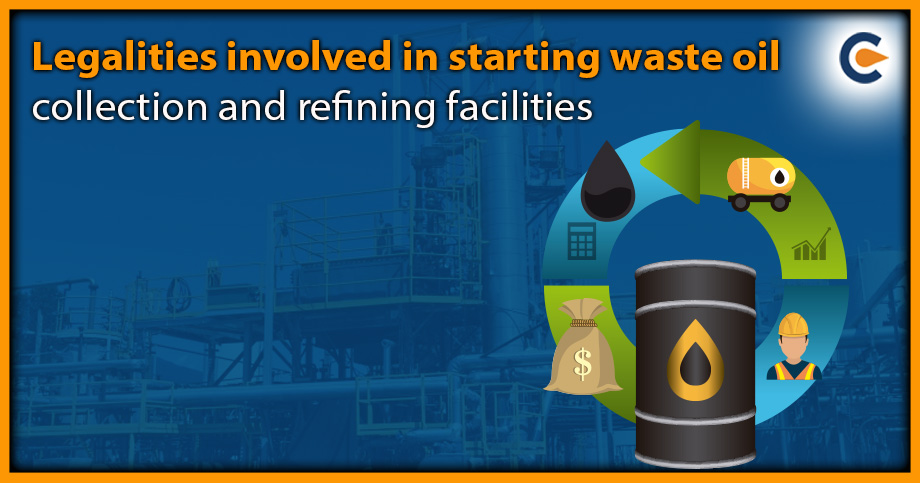Lubricants are subjected to degradation and contamination from continuous operation in various engines to fulfil their intended purpose of reducing friction between components. However, the base oil that is being used retains its chemical properties and can be reused if properly refined and treated, polished and added with the additional elements many manufacturers offer with their products. Lubricants are classified into industrial lubricants, automotive oils and marine oils. With the growing market of India, the consumption of oils has risen exponentially over the last decade, but the refining capacity of the sector is still far behind. After the government announced the EPR regime in waste oil management, there has been a lack of clarity towards the process and also a race to occupy a share in this new segment of waste management. However, the lack of knowledge about the opportunities, roles, and legal responsibilities of waste oil collection and refining facilities has deterred many from stepping into this business. But, by the end of this blog, one would be able to identify the necessary areas they must target to start their own oil collection or recycling facility. Continue reading to understand the legalities involved in the setting up of such facilities
Contaminants in Waste Oil
“Waste oil” refers to oil discarded from automobiles, crude oil processing, emulsions manufacturing, tank bottom sludge, and slop oil from ships and installations. Although waste oil primarily consists of hydrocarbons, it also contains several additives that improve its effectiveness in specific applications.
The type and quantity of additives used depend on how the oil will be used. For instance, lubricating oils often contain 10 to 20 per cent by volume of additives, whereas hydraulic oils only contain a very small amount. While some of these additions can be dangerous to both the environment and human health, others are completely safe.
Due to physical contamination, chemical reactions and wear during usage, waste oil also contains physical and chemical contaminants. For instance, the addition of lead tetraethyl breaks down into lead. Polycyclic aromatic hydrocarbons (PAHs) are produced when organic material, like oils, burns partially, and heavy metal particles are released in the process.
Refining process in waste oil collection and refining facilities
Hydrocarbons are predominantly present in waste oil produced from both industrial and non-industrial sources. Due to physical contamination and chemical reactions that take place during use, it will also contain additives and contaminants. Waste oil has been used in the past, which has caused it to become tainted with contaminants of either chemical or physical nature. Therefore, the following process is used for refining waste oil in waste oil collection and refining facilities.
Step 1: Lab testing and quality assurance
To identify and screen the refining limit value, a lab expert will perform certain tests to examine whether the oil is suitable for refining or not.
Step 2: Physical Filtration
The process begins with straining out any solid contaminants in the oil, such as dirt, mud, etc. Caustic soda or other neutralising agents may be added to neutralise the oil.
Step 3: Subjecting oil to high temperature and low pressure
The fraction is subjected to a high vacuum to lower the boiling point of the oil fractions. A number of cuts can be economically and efficiently separated and condensed, typically producing a low viscosity (~100N), medium viscosity base oil (~300N) or and high viscosity (~500N) cut. Flash-evaporating water and light ends contaminants from the waste oil are performed, and the residual hydrocarbon stream is smeared in a thin film over a large surface area under a vacuum. From there, it’s heated to liquefy all of its components, including chlorinated compounds and other contaminants.
Step 4: Hydro-treatment
Here the sulphur, chlorinated and nitrogenous compounds in the distillate are removed. The unsaturated hydrocarbons become saturated and stabilise to give a base oil that has low evaporation, loss, high viscosity index and low sulphur content. The residue sludge can be used as asphalt extender, further increasing the revenue of the plant from the processed waste. Base oil yields of up to 80% of the feedstock volume are typical, and the balance is made up of water, light ends etc.
Advantages of starting a waste oil collection and refining facilities
Waste oil collection and refining facilities that can refine used oil have a comparatively small footprint with low conversion costs per litre and can add up to 2-3 times the sales value of the oil once processed. A lubricating oil refinery can be designed with many added features, such as using its own fuel from the feedstock being processed to power itself.
A high profit can be made if both collection and recycling activities are performed by the same unit. With a comparatively lower requirement of investment and space to set up a waste oil recycling plant, the unit that can produce high-quality output base oils can be set up easily in any part of the country.
Business Opportunity in waste oil collection and refining facilities
Regarding resource conservation and environmental protection, re-refining spent lubricant oil is a commercially viable recycling technique.
It enables the processing of dangerous materials securely and efficiently in order to obtain a premium base oil product. Old gearbox oil, motor oil, brake fluid, hydraulic oil and gearbox oil are a few examples of waste oil. There is a considerable stock of used oil with collection units that is waiting to be recycled.
At a predicted CAGR of 3.0%, the size of the global lubricants market is expected to increase from USD 157.6 billion in 2020 to USD 182.6 billion by 2025.
Registration Process of Waste Oil Collection Facility
The Central Pollution Control Board (CPCB) oversees registering waste oil collection facilities in India. The CPCB oversees monitoring compliance with environmental laws and rules pertaining to waste management.
To register a waste oil collection facility in India, you will need to follow these steps:
- Depending on where the waste oil collection facility is located, obtain Consent to Establish (CTE) and Consent to Operate (CTO) from the State Pollution Control Board (SPCB)[1] or Pollution Control Committee (PCC) of the Union Territory.
- Submit a request in the format required, along with any supporting documentation (such as a site plan, a layout plan, and specifics about the machinery and equipment used for waste oil collection, storage, and disposal).
- Verify that the waste oil collection facility abides by the requirements and rules established by the CPCB for the management and collection of waste oil.
- Obtain the required approvals from the regional institutions, including the municipal corporation, the fire department, and the health department. The licences and permissions required by the waste oil recycling facility include
- Registration Certificate
- CTE/CTO from the concerned SPCB
- HWM Authorisation
- MSME Registration
- Factory Licence
- Fire NOC
- EPR Registration
Documents Required for Authorisation of Hazardous Wastes
The documents required for HWM authorisation for waste oil collection and refining facilities are as follows:
- Copies of the Aadhaar Card
- Copies of the PAN Card of the applicant.
- Proof of ownership or rental/lease agreement.
- GST certificate.
- Factory or trade license.
- Board resolution appointing an authorised person.
- Electricity bill.
- Certificate of Registration
- Layout plan.
- Memorandum of Association (MOA) and Articles of Association (AOA)
Cost Benefit Analysis for waste oil collection and refining facilities
The HW Management Rules permit recycling and reprocessing of a certain set of recyclable hazardous waste, including waste Oil & lubricants. In light of the rising deficit from importing conventional sources like crude oil, cost effective technologies for oil reprocessing can give our domestic businesses an edge over foreign manufacturers. Moreover, the interest in recycling used oil has increased recently due to environmental concerns about resource conservation, which provides several benefits like
- By using the oil repeatedly, precious oil reserves arepreserved. Prevents ecological destruction and protecting the environment.
- Recycling eases the strain on facilities for storage and disposal. Recycling also substantially reduces carbon footprint.
- Vehicle lube and oil sales represents a substantial base oil consumption, indicating a significant market opportunity for waste oil recycling plants.
Conclusion
It is crucial to remember that the registration procedure for waste oil collection and refining facilities may differ slightly depending on where the waste oil collecting facility is located and which SPCB laws are in effect. It is therefore advised to seek advice from industry experts in the registration procedure for waste oil collection and refining facilities in India from the local authorities or an environmental specialist.
Read our Article:Waste Oil Recycling Business In India And Business Opportunities In The Sector











